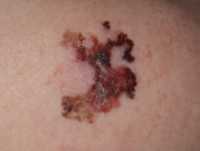
02 Jun EU Discusses Increasing Prevention of Melanoma and Non-Melanoma Skin Cancer
MedicalResearch.com interview with:
 Professor Marie-Aleth Richard
Professor Marie-Aleth Richard
EADV Communications Committee Chair
Professor, University Hospital of La Timone
Marseille, France
MedicalResearch.com: What is the background for this Roundtable event? Would you describe the mission of the European Commission’s Beating Cancer Plan?
Response: Europe’s Beating Cancer Plan is the first, comprehensive EU strategy on cancer, aimed at tackling the disease through all key stages: prevention; early detection; diagnosis and treatment; and quality of life of cancer patients and survivors. The Plan also aims to create opportunities to improve cancer care through research and innovative projects, such as artificial intelligence, and to promote equal access to knowledge and treatments in cancer care across Europe.
The EADV seeks to create a bridge between the EU health policy agenda and scientific research, by engaging with policymakers, patient organisations and other stakeholders to support a patient centric-approach; tackling melanoma and non-melanoma skin cancers (NMSC) at all stages of the pathway, from prevention to follow-up care.
Through our Roundtable event, the EADV brought together these key stakeholders to evaluate the effectiveness of the EBCP on preventing both melanoma and NMSC, as well as identify joint recommendations that step-up measures towards this goal.
MedicalResearch.com: What types of skin cancers are most common in the EU? Most deadly? Most costly?
Response: The burden of cancer is increasing yearly, making it the second leading cause of mortality in the European Union. In 2020 alone, over 106,000 EU citizens were diagnosed with melanoma[i]. On average, one in every six Europeans will be diagnosed with skin cancer during his or her lifetime[ii]. With an ageing EU population, the incidence of skin cancer is likely to continue to increase in the coming years and decades[iii]
Non-melanoma skin cancers, such as squamous cell carcinoma (SCC) and basal cell carcinoma (BCC), are the most common forms of skin cancer, and their incidence is growing.[iv] Non-melanoma skin cancer is also the most widespread cancer amongst fair-skinned individuals.[v],[vi] We have seen data that indicate SCC and BCC comprise around 99% of all non-melanoma skin cancers.[vii]
Malignant melanoma is the most lethal form of skin cancer.[viii] Historically, melanoma was a rare cancer, but in the past 50 years its incidence has risen faster than almost any other cancer.3 According to 2018 estimates, melanoma skin cancer makes up around 3.7% of all new cancer cases in Europe[ix] and a 2020 report estimates that melanoma skin cancer accounts for 0.6% of cancer deaths across the world.[x]
In general, skin cancer is highly preventable and treatable if detected early but creates more disability and mortality than any other dermatological condition if diagnosed late. Research into prevention, early diagnosis, treatment and follow up care of skin cancers is urgently needed and can help reduce costs on society. A 2019 report estimated crude national costs of malignant melanoma were approximately €2.7 billion for all EU countries.[xi]
MedicalResearch.com: Is there a consensus on treatment protocols for melanoma? For use of Moh’s surgery? For skin cancer screening?
Response: European guidelines (European consensus-based interdisciplinary guidelines for
Melanoma) aim to assist clinicians in the diagnosis and follow-up of melanoma. They define the best approaches to cover all stages of cancer prevention and care, and provide protocols for treating patients with invasive and metastatic melanoma.[xii],[xiii]
With European experts coming together, guidelines for the diagnosis and treatment of melanoma are updated regularly to include recent diagnostic strategies and new therapeutic modalities.
MedicalResearch.com: What are the recommendations for narrowing barriers to skin cancer prevention?
Response: Natural and artificial UV exposure is the main cause of non-melanoma skin cancer. It is crucial to define measures to protect children and adolescents, along with outdoor workers who are a high-risk group with constant exposure to UV radiation. Ensuring common policies for adequate sun protection during school hours across Europe and official recognition of UV radiation in key EU legislation related to occupational cancer could pave the way to tackling the problem more efficiently.
Furthermore, common guides and protocols could be implemented to expand the scope of screening initiatives to cover other high-risk groups such as immunosuppressed individuals, organ transplant recipients and patients with hereditary syndromes.
MedicalResearch.com: How has the pandemic affected skin cancer screenings and treatment?
Response: The medical community has been searching for the most appropriate clinical approach and choices during the COVID-19 pandemic. It was important to provide ideal management for cancer patients and to achieve the best possible solutions to address cancer progression while not increasing the risk of infectious diseases such as COVID-19.
As digital tools become more commonplace in dermatological practice, telemedicine has gained significant importance in this era. Thus, we have seen incredible advances and progress in tele-dermatology devices and services. Further research is on the way to improve the accuracy and quality of these devices and services which would also improve and innovate our approach to skin cancer screening, treatment and follow-up even post-pandemic.
MedicalResearch.com: Is there anything else you would like to add? Any disclosures?
Response: Working together within a common goal and programme on issues that deeply affect public health such as cancer is the most important step in achieving success on this path. Thus, this Roundtable event and collaboration between the EADV and EU commission on achieving the Beating Cancer Plan’s mission will help us to address the burden of cancer across Europe.
Roundtable discussion held during the EADV 2021
The event, titled: “Beating Cancer: How to step-up EU efforts on skin cancer prevention” featured speakers from the European Commission’s Beating Cancer Plan Taskforce and EU Parliament as well as representatives from the European Cancer Patient Coalition (ECPC) and European Association of Dermato Oncology (EADO).
References:
[1] Most recent estimates from the European Cancer Information System (ECIS) for the EU-27 countries on melanoma skin cancer incidence and mortality.
[1] De Vries, E., Nijsten, T., Louwman, M.W. and Coebergh, J.W. (2009), ‘Huidkankerepidemie in Nederland’ [Skin cancer epidemic in the Netherlands], Ned Tijdschr Geneeskd, 153, p. A768.
[1] Trakatelli, M. et al. (2007), ‘Epidemiology of nonmelanoma skin cancer (NMSC) in Europe: accurate and comparable data are need for effective public health monitoring and interventions’, British Journal of Dermatology, 156 (Supplement 3), pp. 1-7.
[1] Ciążyńska, M., Kamińska-Winciorek, G., et al. (2021). The incidence and clinical analysis of non-melanoma skin cancer. Scientific Reports, 11(1). doi:10.1038/s41598-021-83502-8
[1] Lomas, A., Leonardi‐Bee, J., & Bath‐Hextall, F. (2012). A systematic review of worldwide incidence of nonmelanoma skin cancer. British Journal of Dermatology, 166(5), 1069-1080.
[1] Eisemann, N., Waldmann, A., Geller, A. C., Weinstock, M. A., Volkmer, B., Greinert, R., … & Katalinic, A. (2014). Non-melanoma skin cancer incidence and impact of skin cancer screening on incidence. Journal of Investigative Dermatology, 134(1), 43-50.
[1] Katalinic, A., Kunze, U. & Schäfer, T. Epidemiology of cutaneous melanoma and non-melanoma skin cancer in Schleswig–Holstein, Germany: incidence, clinical subtypes, tumour stages and localization (epidemiology of skin cancer). Br. J. Dermatol. 149, 1200–1206 (2003)
[1] Matthews, N. H., Li, W., et al. (2017). Epidemiology of Melanoma. Cutaneous Melanoma: Etiology and Therapy, 3–22. doi:10.15586/codon.cutaneousmelanoma.2017.ch1
[1] The cancer atlas. Europe. Available from: https://canceratlas.cancer.org/the-burden/europe/. Accessed May 2021
[1] Sung, H., Ferlay, J., et al. (2021). Global Cancer Statistics 2020: GLOBOCAN Estimates of Incidence and Mortality Worldwide for 36 Cancers in 185 Countries. CA: A Cancer Journal for Clinicians, 71(3), 209–249. doi:10.3322/caac.21660
[1] Krensel, M., Schäfer, I., & Augustin, M. (2019). Cost-of-illness of melanoma in Europe – a modelling approach. Journal of the European Academy of Dermatology and Venereology, 33, 34–45. doi:10.1111/jdv.15308
[1] Garbe C, Amaral T, Peris K, et al; European Dermatology Forum (EDF), the European Association of Dermato-Oncology (EADO), and the European Organization for Research and Treatment of Cancer (EORTC). European consensus-based interdisciplinary guideline for melanoma. Part 1: Diagnostics – Update 2019. Eur J Cancer. 2020;126:141-158.
[1] Garbe C, Amaral T, Peris K, et al; European Dermatology Forum (EDF), the European Association of Dermato-Oncology (EADO), and the European Organization for Research and Treatment of Cancer (EORTC). European consensus-based interdisciplinary guideline for melanoma. Part 2: Treatment – Update 2019.
Eur J Cancer. 2020;126:159-177.)
____________________________________________________
[i] Most recent estimates from the European Cancer Information System (ECIS) for the EU-27 countries on melanoma skin cancer incidence and mortality.
[ii] De Vries, E., Nijsten, T., Louwman, M.W. and Coebergh, J.W. (2009), ‘Huidkankerepidemie in Nederland’ [Skin cancer epidemic in the Netherlands], Ned Tijdschr Geneeskd, 153, p. A768.
[iii] Trakatelli, M. et al. (2007), ‘Epidemiology of nonmelanoma skin cancer (NMSC) in Europe: accurate and comparable data are need for effective public health monitoring and interventions’, British Journal of Dermatology, 156 (Supplement 3), pp. 1-7.
[iv] Ciążyńska, M., Kamińska-Winciorek, G., et al. (2021). The incidence and clinical analysis of non-melanoma skin cancer. Scientific Reports, 11(1). doi:10.1038/s41598-021-83502-8
[v] Lomas, A., Leonardi‐Bee, J., & Bath‐Hextall, F. (2012). A systematic review of worldwide incidence of nonmelanoma skin cancer. British Journal of Dermatology, 166(5), 1069-1080.
[vi] Eisemann, N., Waldmann, A., Geller, A. C., Weinstock, M. A., Volkmer, B., Greinert, R., … & Katalinic, A. (2014). Non-melanoma skin cancer incidence and impact of skin cancer screening on incidence. Journal of Investigative Dermatology, 134(1), 43-50.
[vii] Katalinic, A., Kunze, U. & Schäfer, T. Epidemiology of cutaneous melanoma and non-melanoma skin cancer in Schleswig–Holstein, Germany: incidence, clinical subtypes, tumour stages and localization (epidemiology of skin cancer). Br. J. Dermatol. 149, 1200–1206 (2003)
[viii] Matthews, N. H., Li, W., et al. (2017). Epidemiology of Melanoma. Cutaneous Melanoma: Etiology and Therapy, 3–22. doi:10.15586/codon.cutaneousmelanoma.2017.ch1
[ix] The cancer atlas. Europe. Available from: https://canceratlas.cancer.org/the-burden/europe/. Accessed May 2021
[x] Sung, H., Ferlay, J., et al. (2021). Global Cancer Statistics 2020: GLOBOCAN Estimates of Incidence and Mortality Worldwide for 36 Cancers in 185 Countries. CA: A Cancer Journal for Clinicians, 71(3), 209–249. doi:10.3322/caac.21660
[xi] Krensel, M., Schäfer, I., & Augustin, M. (2019). Cost-of-illness of melanoma in Europe – a modelling approach. Journal of the European Academy of Dermatology and Venereology, 33, 34–45. doi:10.1111/jdv.15308
[xii] Garbe C, Amaral T, Peris K, et al; European Dermatology Forum (EDF), the European Association of Dermato-Oncology (EADO), and the European Organization for Research and Treatment of Cancer (EORTC). European consensus-based interdisciplinary guideline for melanoma. Part 1: Diagnostics – Update 2019. Eur J Cancer. 2020;126:141-158.
[xiii] Garbe C, Amaral T, Peris K, et al; European Dermatology Forum (EDF), the European Association of Dermato-Oncology (EADO), and the European Organization for Research and Treatment of Cancer (EORTC). European consensus-based interdisciplinary guideline for melanoma. Part 2: Treatment – Update 2019.
Eur J Cancer. 2020;126:159-177.)
JOIN OUR EMAIL LIST
[mailpoet_form id="5"]We respect your privacy and will never share your details.
[last-modified]
The information on MedicalResearch.com is provided for educational purposes only, and is in no way intended to diagnose, cure, or treat any medical or other condition. Always seek the advice of your physician or other qualified health and ask your doctor any questions you may have regarding a medical condition. In addition to all other limitations and disclaimers in this agreement, service provider and its third party providers disclaim any liability or loss in connection with the content provided on this website.
Last Updated on June 2, 2021 by Marie Benz MD FAAD
